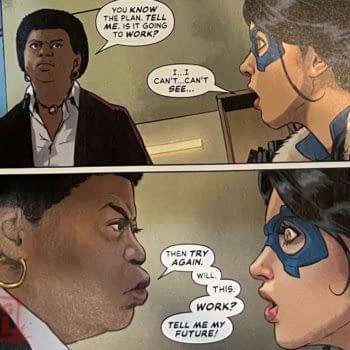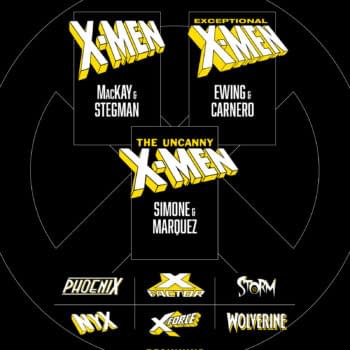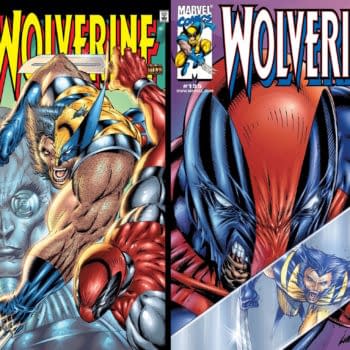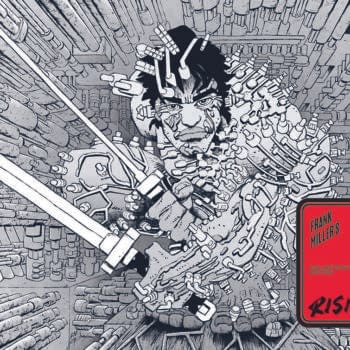Posted in: Comics, Recent Updates | Tagged: Comics, dc comics, entertainment, grant morrison, The Multivrrsity Guidebook
The Rose In Winter – Sitting Down With The Multiversity Guidebook
By Nas Hoosen
And we're back. Sort of. The second-to-latest issue of The Multiversity, the Guidebook, has been out for over a month now, giving you ample time to catch up and while I got my ducks in a row. You may have noticed that my pieces on both Pax Americana and Thunderworld didn't end up here at Bleeding Cool. That's because of a laptop crash that sucked my extensive write-up on the former into the void (but let's blame The Gentry, shall we?). From then on I just struggled to get back on schedule and in that time, well, A LOT of people wrote about Pax. Most helpful as always was the work of David Uzumeri over at Comics Allianc, and an interview from Matt Wilson at that same site, in which Grant Morrison confirmed a lot of the thinking that we've seen pop up in dissections of this story all across the comics (and sometimes the non-comics) internet.
On one hand, that interview was great. On the other, it's kind of sad that a little of the mystery and fun of reading into things has now been confirmed by Morrison himself, prior to the story's actual wrap-up. Knowing things with a degree of certainty is a little like being Captain Atom in the middle of Pax Americana. It's not the same. Still, if any point felt like it was good for a discussion of the story's implications up until this point, it was post-Pax, the series' halfway mark and also the issue that most people have waited years to read.
In many ways, Thunderworld took the concepts in Pax and simplified them down even further, presenting them in the way only a classic CC Beck style Captain Marvel adventure could, rather than in the heavily constructed style of Alan Moore. If Pax Americana presented readers with the thunderbolt moment of enlightenment, presenting its "lead" President Hartley with a complicated view of reality on which to base his entire life, Thunderworld traced that lightning bolt directly to its source at the Rock of Eternity. That scene where Shazam was trapped behind bars that formed a rigid 8-panel grid over his viewpoint, just as he was chastising Dr. Sivana for sucking all the magic out of life… well, that right there is the essence of what Morrison is saying about narrative in this series, and the relationship between the readers and the characters.
It feels like, now that the series is done making fairly specific denouncements of violence, grim and grit (although the Guidebook has one of those), things are starting to take the shape of the larger story, shifting gears here with a team-up between the Chibi Batman of Earth-42 and his Atomic Knight counterpart from Earth-17. This issue also gives us strong insight into Multiversity's villains, as well as providing a strong statement from Morrison on the nature of the DC Multiverse as a whole.
So, with the catch-up out the way, let's jump straight into The Multiversity Guidebook.
[*SPOILERS FOLLOW!]
Earth-42
Things kick off with an introduction to the Chibi Justice Club of Earth-42, who are being mowed down by the serial killer iteration of Dr Sivana that made his first appearance back in Thunderworld. Through the guidebook portion of this very issue, we learn that Earth-42 never knew violence until they encountered the Superman analogue Super-Doomsday during Morrison's Action Comics run. That corporately corrupted monster killed their version of Superman, introducing the sort of violence into their universe that we now see reiterated in the actions of the murderous Sivana and his excited Chibi counterpart, who has never actually killed anyone in his playground-like conflicts with the heroes. The whole notion of violence revisiting these characters once their Superman was killed speaks to Morrison's overall sentiment about stories in the DC Universe. Their introduction to mortality by way of another Earth's interference has now permanently tainted the narrative of Earth-42 with the possibility of violent death, in very much the same way that The Death of Superman on what is now Earth-0 could be seen as encouraging DC to kill off pretty much every major character they hadn't already gotten around to offing back in the 90s. Well, Batman was only paralyzed and Wonder Woman ascended to godhood, but the idea that DC liked to violently dissect their characters in the 90s still stands.
That the issue opens with Chibi J'onn J'onnz crying out his deceased wife's name as he's burned to death by a homicidal bald man is a direct call-back by Morrison to his own "murder" of the Martian Manhunter back in Final Crisis issue 1 seems like the author joking at his own expense. When we learn the Chibi League's dark secret later in this issue – that they're all actually robots – it makes the metaphor that they are nothing but creations (albeit creations with real lives, personalities and souls even) to be sliced and diced for entertainment value that much further. Who designed them? Why? I doubt we'll ever learn the answer in Multiversity, but it makes its point clearly enough. These characters are presented as charmingly real until the rug is pulled out from them, revealing that they're nothing more than constructs. Poor Chibi Dick Grayson.
We're also told at this point that the Transmatter Array device is "word-controlled", implying a strong connection between the device and the machines used by the New Gods. In fact, the Transmatter cubes most closely visually recall the appearance of a solved Rubik's Cube, which is the device that Metron uses to transform/reactive Nix Uotan into Monitor/The Judge of All Evil back in Final Crisis issue five. That's also an object we see in Nix's bedroom in Multiversity #1, and it's seen lying around on the floor in Dr Sivana's lab on Earth-42 here as well. Ultimately it hints at a connection between the Transmatter devices and the New Gods, or the Monitors, and restates the idea that words have power and can transform ordinary people in meaningful ways.
Words have consequences. Stories have consequences. That's something Grant Morrison has often asked us to take note of, and he's doing it again here.
Earth-17

Batman-17 makes a reference to the Four-Stone, which sounds like it could be a die, or his Earth's version of a Transmatter device. He also brings up Darkseid for the first time in this series, and there's a character I figured wouldn't fit into The Multiversity and yet here he comes. This Batman also uses a gun because he watched his parents mutate into shambling zombies when he was a child… Rough.
We also learn that the Sivanas of at least 25 Earths improved on the designs of the Transmatter Cubes, which could only transport inorganic matter across worlds at the onset. At first thought, this doesn't seem to make much sense, since Lex Luthor designed the one on Earth-23 and that did a fine job of bringing people from alternate Earths through to his world. I did notice that one of the Sivanas is a robot, presumably from Earth-44 (mentioned later as the source of the robotic Metal League) so maybe this whole Invasion of the Sivanas started with him? This also suggests an explicit connection between The Gentry and the Sivanas.
More important to the Multiverse itself, however, is that the Sivanas are still floating around in their artificial Rock of Eternity, which is said to be "vibrating in the bleed space between universes". Lecter-Sivana also refers to something being "much smaller on the inside than it looks from outside". I'm assuming he's talking about the Rock, and that this is just a joke at the expense of the various Sivana's egos, but if I'm wrong he could be referring to The Bleed itself. I suppose that if any space in the DC Multiverse were to be smaller on the inside than it appears, it would be The Bleed. That might also explain why Hellmachine of The Gentry is suddenly so enormous at the end of this issue, since Bleed Space is just the gutters that exist between panels of comics; a void that can devour infinite time and space from the narrative and yet is actually fairly tiny in stature on the page.
Let's just take a moment to take stock of how many things/objects are actually floating through Bleed Space right now. We know that there are ships capable of doing this, like the Ultima Thule, but so far in Multiversity we also possibly have the House of Heroes, Rock of Eternity, fake Rock of Eternity and that monstrous and as-yet-unexplained multi-faced mass from Chapter One just hanging out at different points in the empty spaces between worlds. I still feel like that mass from #1 is actually the total embodiment of The Gentry, with the various demons we've seen acting more like individual aspects or sprites of that whole thing, but I've got nothing to go on there besides the fact that it hasn't shown up again and yet it seemed to get a noticeable placement without any explanation. Then again, maybe it has more to do with Darkseid?
Earth-51
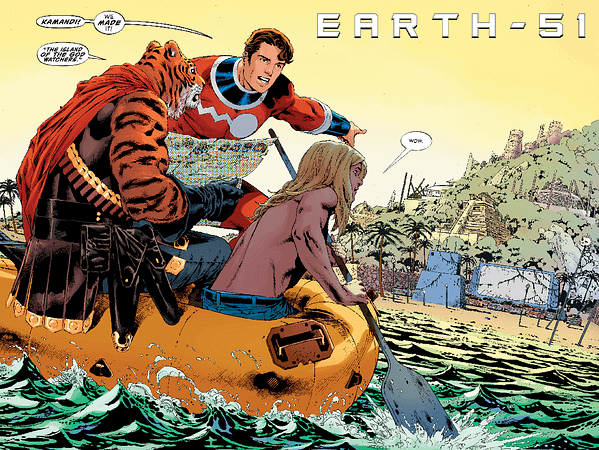
Kamandi & Co are approaching the Island of the God-Watchers, which comes complete with an old drive-in. While that works perfectly well with the idea of Kamandi living in a post-apocalyptic future, it also speaks to the nature of stories as projections onto a blank slate that the audience participates in by monitoring things. The derelict blank screen is as much a void as the blank comics page or the Over-Void that the DC Multiverse floats within, and the rows of empty cars sitting in front of the screen suggest an absent audience. We're "God-Watchers" too after all, taking a look at the proceedings of our superhero counterparts through the pages of these comics. Of course that's also a play on words, since the island is being watched over by a group of benevolent Watcher-Gods, all of whom are fixated on playing sentry over the tomb of the recently returned dead god, Darkseid.
Kamandi's trio is looking for his companion Flower which, along with the presence of an actual single rose on the desolate island speaks to a connection between Earth-51 and Earth-17, at least thematically. If a flower can grow in this post-apocalyptic wasteland – this eternal winter – it proves a symbol of the resilience of life in an environment that should kill everything. We saw a similar symbol of Earth-51 as embodying that sort of value at the end of Final Crisis, where a flower apparently bloomed in the post-Great Disaster wasteland, suggesting that life won out.
The DC Multiverse itself is a sort of flower then, able to survive the harsh winters of its existence, the various Crises, and bloom again once they're over.
Nu-Godz
Although Final Crisis implied that the New Gods would be reborn in new forms after that event, The New 52 has presented them in a fairly similar manner to the one they've always taken. They've apparently been slumbering on New Genesis, waiting to restore their power, and while they did Darkseid awoke and snuck back into the Multiverse. That would explain why he's shown up in Geoff Johns' Justice League run, alive and well. We're told here that he "wears many faces. All grim." That seems like a fairly on the nose reference to grim & gritty comics, sure, but also implies that his evil is poisoning the Multiverse in new forms. Is this what The Gentry are? Pawns of Darkseid? That seems too simple, but it does fit with their M.O. and their access to an Anti-Death Equation, which sounds like something a zombified resurrected Darkseid would be pretty into. This is the God of All Evil, a guy with a mad-on for an equation that forces life to be lived as an expressionless drone. He'd be pretty big on a death that hinders transformation too.
At the same time, I don't buy that Morrison would be using Darkseid when Geoff Johns so clearly has plans for him.
Tuftan points out the drawings on the tomb walls, which tell the story of creation in a proto-comic form. Ben Boxer makes a point of saying that "Stories can be dangerous", which is the thesis for this series and was for Final Crisis too. Stories have an effect on our mindset, and shape the way we interact with the world around us. We have to be careful what stories we tell and read, and take responsibilities for the ones we share with others. Morrison said this outright over at Comics Alliance (seriously, go read that interview).
The History of the Multiverse

Basically, we're being told that story itself originates in conflict, and so the entire creation of the DC Multiverse originates within the conflict between the void of the blank page and someone's decision to produce art on its surface. There was a flaw in perfection, and that flaw "is" while the perfect void that existed before it was not. Monitor-Mind is the consciousness that developed when this blank slate noticed the flaw on its own surface, and the Anti-Monitor is the representation of its sudden sense of duality. The pair of eyes we see watching over everything look a lot like the Egyptian Eye of Horus and its counterpart, the Eye of Thoth.
The Eye of Horus, on the right, is associated with summer and the sun, as well as divine kingship and reunification. The Eye of Thoth has ties to winter and the moon, and is linked to restoration and popular wellness. The right eye represents the supreme and self-created God, while the other is eventually given a secondary role and embodied by a cobra, perhaps suggesting a link to the Devil by way of the snake metaphor. (You can read about this in a lot more detail here http://www.sofiatopia.org/maat/eyes.htm). In essence, one eye is Monitor and the other is Anti-Monitor. Both actually belong to Monitor-Mind, which is personified in duality and conflict because it is observing itself.
Monitor-Mind is the consciousness of the blank slate or Over-Void, a pair of eyes on the wall that gaze at the wall itself, in much the same way human consciousness appears to stem from our constant reflection on the internal workings of our own minds. Monitor attempted to contain the flaw it saw in itself, and the resultant conflict, in the form of a story.
We can relate this to Pax Americana's discussion of the way consciousness attempts to enforce structure on chaotic existence. The implication here is the same as what Shazam says to Sivana in Thunderworld; trying to contain, explain and understand the DC Universe is what causes the DC Universe to become unnecessarily convoluted, hindering it from growing exponentially to encompass Monitor, or to reach its full potential. The entire DC Multiverse is the rose that grows in winter, somehow able to sustain itself in an environment that should be killing it just by the act of attempting to contain it. No coincidence then that a blank white page provides a similar effect to a snowy winter landscape.
Sometimes when you think about something too much, Monitor, you're just left with the pieces of something beautiful rather than the magic of that first sensation of discovery.

The lightning bolt, or rather the thunderbolt, is a symbol associated with The Tower card in the traditional Tarot deck, and with the zig-zag Magician's Path. The symbol speaks to a sudden upending of the structures and beliefs that help shape and define a person's life. It can be positive or negative, depending on how you choose to interpret its effects, but even a novice magician will tell you that its effect in your life can be dramatic as hell. That we've had towers appear in Pax Americana, a mention of a Dark Tower here, and traced the source of the thunderbolt that strikes the Tower in the Tarot last issue, I'd say that none of this is incidental on Morrison's part.
The symbol can be summed practically as the conscious relationship that occurs within every human being, who encounters themselves on occasion and, in a fit of self-awareness or self-consciousness, rebels against their idea of self by moving swiftly in a new direction, constructing an 'other' self to compensate or represent the change in their lives. It is the idea engine of creativity.
Morrison has often suggested that the Multiverse is sentient. He seems to be taking that idea a step further here, suggesting that it reinvents itself with each new era because it has become self conscious or aware of itself again. The conflict between heroes and villains, or Monitor and Anti-Monitor, is only the internal dialogue of a single entity, embodied in the stories. It is also why the DCU gets so serious and horrific at times, because it's attempting to respond to its brighter nature by creating a more serious version of itself. This is perhaps best embodied on Page 1 of this very comic, when the two Sivanas are shown to be a horrific murderer and an adorable Chibbi who has never killed anyone and whose conflicts with heroes are just games. There are always two versions of the DC Universe that coexist, and if we tell the right kinds of stories, we can help the brighter and more divine side win out.
What's so great about Morrison's presentation of the History of the DCU here is that it's an all-inclusive mixing and matching of the company's entire publishing history, turning the reboots and rebrandings that sometimes irritate fans into a pivotal aspect of the ongoing story of this real place, rather than the actions of a weary publisher. We might not like it when the things we love change, but we can understand it.
The Multiverse Guidebook
The guidebook portion of the issue is a fun read on its own, but there are really only two bits I'm going to draw attention to for now. One is the 7 Unknown Worlds that we're told were "created by an Inner Chamber of 7 Monitor Magi for a mysterious purpose yet to be revealed." This is a neat way of saying that Morrison left a few Earths behind for other writers to have fun with, but it also implies the presence of 7 still living Monitors after their race vanished at the end of Final Crisis. Perhaps this is a nice way of providing a new role for Morrison's 7 Unknown Men from back in 7 Soldiers?
There's also Earth-15, which was destroyed during Countdown and has been reduced to a "Cosmic Grail" that's hidden on another Earth in the Multiverse. I imagine this has implications for this story, but maybe not.
The Empty Hand

Is it Darkseid? Is it the Anti-Monitor? Is it Grant Morrison? Or something else altogether? At the end the Empty Hand speaks, telling the characters to rise from the dead and to die again as they have many times before. It's implied that this is the voice of that total conflict, Monitor-Mind itself, preparing to destroy everything for reasons as yet unknown. Perhaps because it has been corrupted by its interaction with new kinds of stories. Maybe we'll find out in Master Men.
For Nas Hoosen's previous essays on Multiversity, find them here.
Nas Hoosen is the co-founder of Another-Day, South Africa's Least Favorite Website About All Its Favorite Things. Sometimes he still has 'Nam style flashbacks to his time spent working the counter at the local comic shop.












